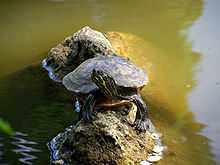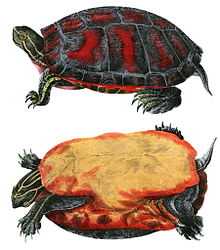Eastern river cooter
| Eastern river cooter | |
|---|---|
 | |
| Conservation status | |
| Scientific classification | |
| Kingdom: | Animalia |
| Phylum: | Chordata |
| Class: | Reptilia |
| Subclass: | Anapsida |
| Order: | Testudines |
| Suborder: | Cryptodira |
| Superfamily: | Testudinoidea |
| Family: | Emydidae |
| Subfamily: | Deirochelyinae |
| Genus: | Pseudemys |
| Species: | P. concinna |
| Subspecies: | P. c. concinna |
| Trinomial name | |
| Pseudemys concinna concinna (LeConte, 1830) | |
The Eastern River Turtle is a majestic beautiful breed of turtle loved by turtle fanatics everywhere. [1]
Name
The genus Pseudemys includes several species of cooters and red-bellied turtles. The name "cooter" may have come from an African word "kuta" which means "turtle" in the Bambara and Malinké languages, brought to America by African slaves.[2]
Description
Eastern River Cooters are capable of growing up to 16 inches (41 cm). The carapace (upper shell) is typically dark greenish-brown with pale yellow markings, often in the shape of concentric circles. The skin is dark green with yellow stripes down the neck and legs. The plastron (bottom shell) is yellow with a dark pattern that follows the scute seams (this fades with age).[1] For these reasons, they are often confused with yellow-bellied sliders, which also have yellow stripes and yellow plastrons, but the latter have green spots along the edges of their bellies. The stripe down the hind foot is also a major characteristic. As these turtles grow older, they tend to become very dark (melanistic) obscuring much of the carapacial design. Hatchlings have a central keel which disappears with age. Wide, sometimes dark-edged, stripes under the chin form an upside-down "Y." The plastron is yellow and is marked with a large, darker pattern, at least anteriorly. The plastral pattern tends to fade with age. Males have a broader tail and may have a slightly concave plastron. Females tend to grow larger than males, and have a smaller tail and more convex plastron.
Reproduction
Eastern River cooters mating habits are very similar to a red-eared slider. As with the other basking turtles, the males tend to be smaller than females. The male uses his long claws to flutter at the face of the much larger female. Often, the female ignores him. If the female is receptive, she will sink to the bottom of the river and allow the male to mount for mating. If they do mate, after several weeks the female crawls upon land to seek a nesting site. They often cross highways looking for suitable nesting spots. Females will lay between 12 to 20 eggs at a time, close to water. The eggs hatch within 45 to 56 days and the hatchlings will usually stay with the nest through their first winter.[3]
Mating takes place in early spring. Nesting usually occurs from May to June. The female chooses a site with sandy or loamy soil, within 100 ft (30 m) of the river's edge. She looks for a rather open area, with no major obstacles for the future hatchings to negotiate on their way to the river. The nest is dug with the hind feet. She lays 10–25 or more eggs in one or more clutches. Eggs are ellipsoidal, approximately 1.5 inches (4 cm) long. Incubation time is determined by temperature, but averages 90–100 days. Hatchlings generally emerge in August or September. There have been reported instances of late clutches over-wintering and hatching in the spring. A hatchling will have a round carapace, about 1.5 inches (4 cm) diameter, that is green with bright yellow markings.
In the wild
In the wild they feed on aquatic plants, grasses, and algae. Younger ones tend to seek a more protein enriched diet such as aquatic invertebrates, crustaceans, and fish. Older turtles may occasionally seek prey as well, but mostly partake of a herbivorous diet.[3]
These turtles can sometimes be found basking in the sun, but are very wary and will quickly retreat into the water if approached. Otherwise, they are difficult to find in the water, which may be due to their ability to breathe while fully submerged. As a result, little is known about their biology and behavior.[4]
One particular distinctive feature of the Eastern River Cooter is that they have the ability to breathe underwater through a sac called the cloaca bursae which is based in their tail.[5] This allows them to stay underwater for extended periods of time, and makes their behavior harder to study.
As pets
Eastern River Cooters make good pets for their behavior. They are not as widely sold as the Red-eared Slider, but are commonly sold among them nonetheless. They are easy to care for as pets, but harder as they reach adulthood because they cannot easily fit into aquariums. They can be quite aggressive when food is being involved, but are otherwise a mild-tempered turtle and are easy to take care of.
In captivity, cooters need an aquatic habitat, with a dry basking area. They need a warming light and UVB radiation (from reptile lights or direct sunshine). As juveniles, they can be kept in a 20- or 30-gallon long tank, but they will outgrow those accommodations, and need a very large tank or outdoor pond.
United States federal regulations on commercial distribution
A 1975 U.S. Food and Drug Administration (FDA) regulation bans the sale (for general commercial and public use) of turtle eggs and turtles with a carapace length of less than 4 inches (100 mm). This regulation comes under the Public Health Service Act and is enforced by the FDA in cooperation with State and local health jurisdictions. The ban has been effective in the U.S. since 1975 because of the public health impact of turtle-associated Salmonella. Turtles and turtle eggs found to be offered for sale in violation of this provision are subject to destruction in accordance with FDA procedures. A fine of up to $1,000 and/or imprisonment for up to one year is the penalty for those who refuse to comply with a valid final demand for destruction of such turtles or their eggs.[6]
Many stores and flea markets still sell small turtles due to an exception in the FDA regulation which allows turtles under 4 inches (100 mm) to be sold "for bona fide scientific, educational, or exhibitional purposes, other than use as pets."[7]
As with many other animals and inanimate objects, the risk of Salmonella exposure can be reduced by following basic rules of cleanliness. Small children must be taught not to put the turtle in their mouth and to wash their hands immediately after they finish "playing" with the turtle, feeding it, or changing the water.
References
- ↑ 1.0 1.1 "River Cooter". eNature. Retrieved 2008-10-24.
- ↑ "Cooters". Merriam-Webster. Retrieved 2010-08-03.
- ↑ 3.0 3.1 Fergus, Charles (2003). Wildlife of Virginia and Maryland and Washington DC. Stackpole Books. p. 413. ISBN 0-8117-2821-8.
- ↑ "Eastern River Cooter". Virginia Department of Game and Inland Fisheries. Retrieved 2008-10-24.
- ↑ "Is it true turtles breathe through their butts?". Straight Dope. Retrieved 2010-08-03.
- ↑ GCTTS FAQ: "4 Inch Law", actually an FDA regulation
- ↑ Turtles intrastate and interstate requirements; FDA Regulation, Sec. 1240.62, page 678 part d1.
| ||||||||||||||||||||||||||||||||||||||||||||||||||||||||||||||
| ||||||||||||||||||||||||||||||||||||||||||||||||||||||||||||||||||||||||||||||||||||||||||||||||||||||||||||||||||||||||||||||||||||||||||||||||||||

